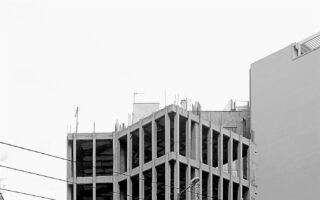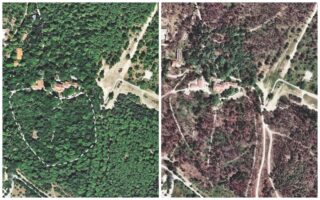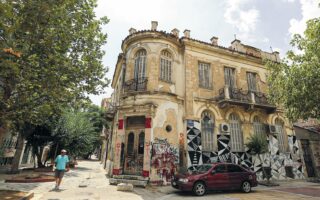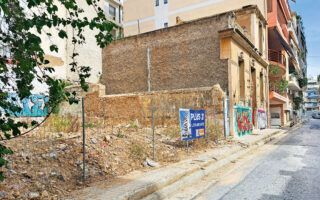‘I believe we got it right the first time’
Fifteen years after the opening of the Acropolis Museum, French-Swiss architect Bernard Tschumi revisits the experience of designing it

For many years, French-Swiss architect Bernard Tschumi was an almost unwanted person in Greece, at least for those who knew his name and associated him with the first and most emblematic public building constructed in Athens in the 21st century. The Acropolis Museum, one of his most important international projects along with the Parc de la Villette in Paris, had received relentless criticism, especially here in Athens. The sturdy metal and glass structure built between the excavations and the Weiler Building had been criticized by much of the public and a section of the architectural community as “arrogant,” “disrespectful” to the landscape, and “in competition with” the “Sacred Rock” of the Acropolis and the Parthenon.
Fifteen years after the inauguration of the Acropolis Museum on June 20, 2009, when post-Olympic Greece was struggling to preserve some of its illusory glow, the great architect, theorist and academic returned this week to Athens to receive an honorary doctorate from the Department of Architecture at the University of Patras’ School of Engineering.
Tschumi’s arrival coincides both with the 15-year anniversary of the museum he built and the imminent opening (June 26) of the Museum of Excavation in an area of 4,000 square meters over which his architectural concept rests. Much has changed in Greece between 2009 and 2024, but as far as the French-Swiss architect is concerned, the most important change has to do with the rapid integration of the Acropolis Museum into the urban fabric of Athens.
It’s been 15 years since the opening of the Acropolis Museum. What are your memories of the years of the architectural competition and the subsequent construction of the museum?
Extraordinary enthusiasm and generosity of purpose. Everyone rose to the challenge, whether they were archeologists, architects, or builders. This is rare.
During your visits to the museum in the years following the official opening, have you thought about aspects of it that in retrospect you would have handled differently on the design table?
Surprisingly enough, no! Something incredible happened: I believe we got it right the first time.
Given the upcoming official inauguration of the ancient city sublayer at the Museum of Acropolis, how important is the subworld of the ancient findings under the museum for you? I have noticed that some columns have the form of a tripod at the bottom part to avoid destroying the ancient sublayer. How did you conceive of this juxtaposition of history in such a contemporary building?
The whole Acropolis Museum is about the superposition of three layers: the excavations, the central concrete core, the glass Parthenon Gallery. It was conceived in this manner. And yes, I thought it was nice to invent a new type of column, the tripartite column, which allows the protection of historical remains while insuring the stability of the new construction.
The return of the Parthenon Marbles has been back in the public debate and in the news during the last two years. Do you consider yourself as a part of the campaign? Could you risk making a prediction about the fate of the Greek request?
I have always been in favor of the return of the marbles. It’s only a question of time.
Would you say that the construction of the museum brought you closer to Greece? I’ve heard that in your New York office there’s always at least one Greek architect.
Both the design phase and the construction phase were an amazingly positive experience. At least one Greek architect in my office? Amusing and partly true, but it’s actually quite coincidental.
You started out as a theorist but you’ve evolved into one of the biggest names of architecture internationally. How do you handle this double identity? How do you keep the right balance between the professional architect and the theorist/academic aspect?
A very good question. But I believe that in architecture, theory and practice are inseparable. 2,500 years ago in Greece, architecture influenced philosophy as much as philosophy influenced architecture.
‘2,500 years ago in Greece, architecture influenced philosophy as much as philosophy influenced architecture,’ says Bernard Tschumi
You served as the dean of Columbia’s School of Architecture in New York for 15 years, during which the school was established on the international stage as one of the pre-eminent centers of creativity and innovative architectural thought. What was your main vision and what are the secrets of a good educator? Have these secrets changed in contemporary architectural education vis-a-vis architectural education when you started teaching?
Just as theory and practice cannot be separated, what is done in architecture schools often influences the profession, and vice versa. Think of the Beaux-Arts, Vkhutemas, the Bauhaus: They were incredibly influential schools. But the influences go both ways. Invention is sometimes purely in the mind and sometimes a function of the construction industry…
It seems that we are gradually leaving behind the era of star architects and eminently monumental buildings in terms of their form. Since you were part of that era, how do you evaluate those years given the time distance?
In architecture, like everywhere else, there are cycles that may depend on changing social or economic issues. One should remember that in the 1970s, there was very little work for young architects, which gave them time to become imaginative. Then, they eventually started to build. I also believe that architectural competitions are extremely important. That’s what made the difference, from the 1980s to the 2000s. But there are fewer architectural competitions today.
Leaving behind a somewhat more “form-centric” approach to architecture, we are exploring new priorities connected with the imperatives of the climate crisis. Where are we today as we walk down this road and how do you view the new generation of architects?
I believe architecture is not simply about a knowledge of forms: It is about concepts and ideas. The climate crisis presents a good opportunity to invent the impossible: new concepts that transcend the issue of climate change and turn it into a positive factor of invention.
More and more architects are urban planners as well. More and more urban planners are involved in design. Do you consider yourself an architect, an urban planner or both?
Good question. I wouldn’t separate the two.
We mark 40 years since the Parc de la Villette, 25 years since Miami’s FIU School of Architecture, 15 years since the Acropolis Museum. Do you ever post-conceptualize these projects? Considering your role as an urbanist, how do you believe these projects have transformed their contexts and adapted to their social environments over time?
I often try to post-conceptualize these projects, trying to get an overview of what they represent in terms of what architecture actually is. I don’t believe in “-isms” (post-modernism, regionalism etc). I believe that architecture is a form of knowledge. And, yes, projects like the Parc de la Villette in Paris were and are important both socially and culturally.
Do you envision your recent major project in Paris as an urban-scale project or as a large complex of buildings? Additionally, was there a site-specific concept guiding this project?
The very large Biology-Pharmacy-Chemistry Center for the University of Paris-Saclay was indeed an urban design project as much as an architectural project.
Out of all the cities in which you have built or proposed a project, which urbanscape, city or context aligns best with your architectural vision and ideas? What would you think about a “no context project”?
Utopia is a “no context project.” But all built architecture has a context of sorts. It’s not necessarily a visual context: It can be about society, or about climate…
Ancient civilizations have marked the world by building monuments that have passed the test of time over thousands of years. The Parthenon is 2,500 years old. Do you think there are buildings around the world constructed during our contemporary era that are destined to carry over our own cultural signal to the next millennia?
A difficult question. In the 19th century a major writer, Victor Hugo, wrote, “This will kill that”: The word will kill the monument. But architecture is still here, its definition still in constant flux.
Finally, is there a question that you would rather ask yourself? Is there something that you would like to be asked or something that you would like to say to our readers?
Concept and context, concept and experience, concept and material have historically been very important to my work. But more recently, I’ve become most interested in the poetic dimension of architecture, where everything cannot be explained in a rational way.





